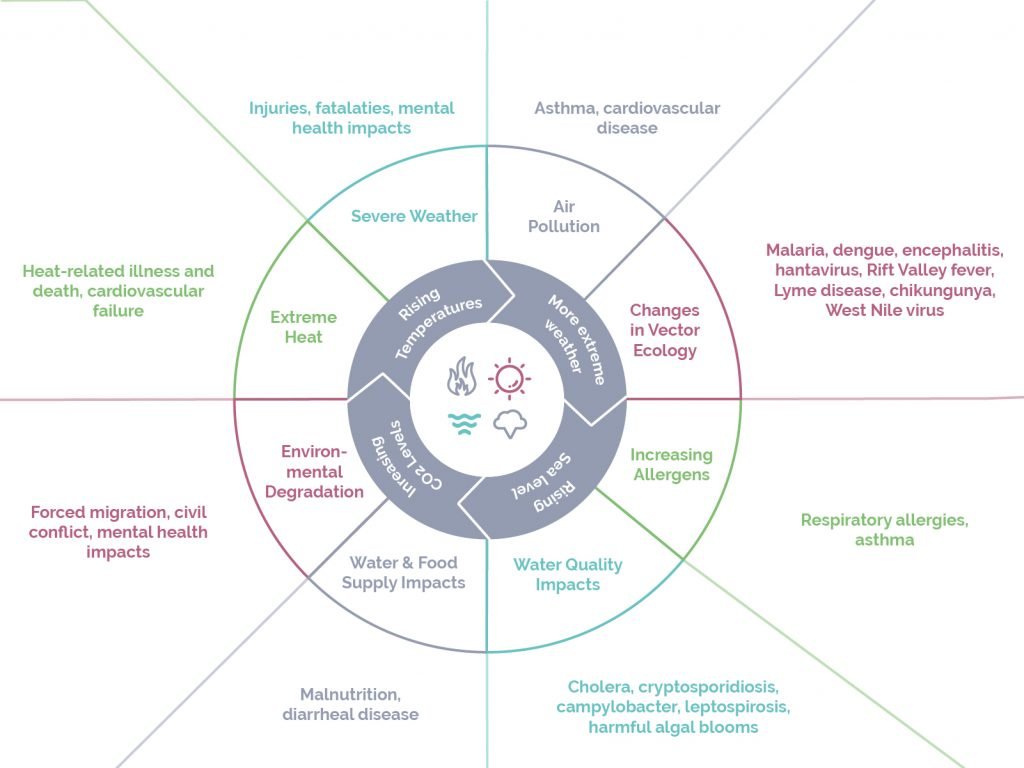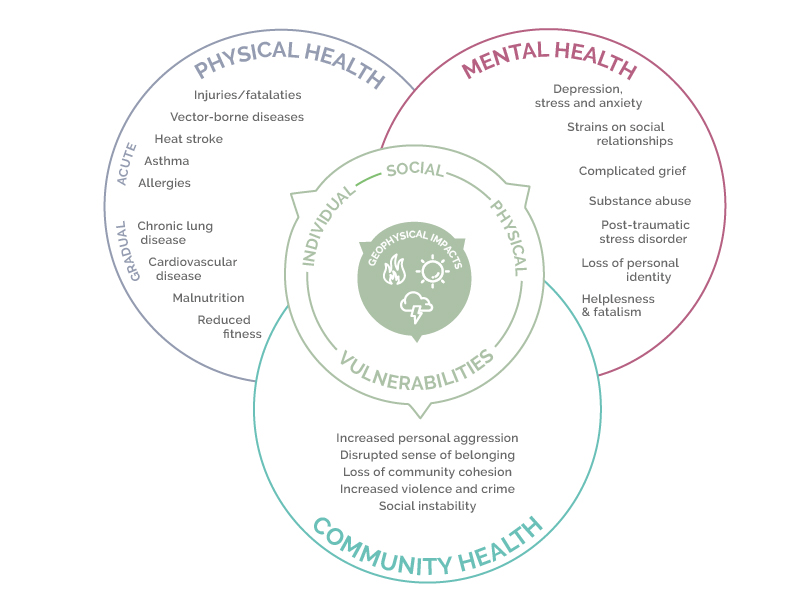6 minute read
**TRIGGER WARNING – THIS SECTION CONTAINS REFERENCE TO MENTAL ILLNESS INCLUDING SELF-HARMING AND SUICIDE. **
In the previous sections we have touched briefly on some of the health impacts of climate change. This section discusses in more detail the mental and physical impacts of climate change.
Impact of climate change on human health

Physical health impacts of climate change
 Read: Mental Health and Our Changing Climate: Impacts, Implications, and Guidance pg. 11 – 13
Read: Mental Health and Our Changing Climate: Impacts, Implications, and Guidance pg. 11 – 13
Key points:
- Mental health can be impacted by damage to the physical and social community
- The primary ways geographical changes impact human health can be grouped into two categories: acute and chronic.
- Acute (short-term) impacts:
- Direct physical impacts from climate related disasters can range from physical injury to increased frequency of infectious disease, asthma, heart disease and lung problems, all of which can affect mental health.
- The direct effects of natural disasters are often exacerbated by indirect consequences in the following weeks and months. This can include damage to infrastructure such as sanitation, power systems and the disruption of medical services.
- Chronic (long-term) impacts:
- Severe and changing weather
- Increased average temperatures and periods of hotter than normal temperatures can increase rates of heat exhaustion, heat cramps, heat stroke and hospital admission for heart-related illnesses.
- At the other extreme, periods of colder weather increase instances of hypothermia and frostbite.
- Changing weather patterns also influence migration patterns of animals and insects resulting in the spread of vector-borne illness such as malaria, dengue fever, plague, and Zika virus.
- Respiratory issues and allergens
- The effects of air pollution caused by cars and industrial facilities are intensified by warmer temperatures and increase the rate of hospitalisation for respiratory issues and deaths from strokes and heart attacks.
- Hotter and drier summers increase the rate of forest fires and health conditions due to smoke inhalation.
- Allergy seasons are extended due to warmer temperatures.
- Foetal and child development
- Physical stress on mothers can cause premature births and low weights at birth.
- Children and foetuses are at particular risk from air pollution, heat, malnutrition, infectious diseases, allergies and mental illness.
- Water and food supply
- Nutrition levels in food and availability of food can be impacted as climate patterns impact agriculture.
- Damage to infrastructure can also make access to food harder.
- General fitness
- Increasing temperatures and decreasing air quality may impact the type of fitness activities that people can engage in, potentially leading to a reduction in exercise and subsequent general fitness.
- Severe and changing weather
- Acute (short-term) impacts:
Mental health impacts of climate change
The American Psychology Association (APA) describes eco-anxiety as “the chronic fear of environmental cataclysm that comes from observing the seemingly irrevocable impact of climate change and the associated concern for one’s future and that of next generations”. 1
Levels of eco-anxiety are on the rise, particularly among children and young people. In a survey of 10 countries, more than 45% of young people said their feelings about climate change “negatively affected their daily life and functioning”. Anxiety stems not only from fear of the consequences of climate change but also from the indifferent reactions that warnings of climate change are met with by global leaders and policy makers. 2
Evidence suggests a clear relationship between experiencing the effects of climate change and increased risks of depression, low mood, extreme mental distress, post-traumatic stress disorder, suicide and worsening of existing mental illnesses. 3
The diagram below illustrates the interrelation between physical health, mental health and community well-being. 4
Linking physical impact metal health and community well-being

Extreme weather events can cause extreme emotional reactions that may interfere with our ability to think rationally, plan our behaviour and consider alternative actions. They can be a source of trauma that prompts a heavy emotional reaction such as uncertainty and fear about one’s own vulnerability (however realistic). This can also be a source of stress that can prompt irrational behaviour and impair physical and mental health. The physical and mental health of residents in a community affect the overall community’s health. Climate change can have a particularly powerful effect on community fabric and interpersonal relationships. Changing environmental conditions can cause:
- Decreased sense of cohesion
- Disrupted sense of continuity and belonging
- Increased interpersonal aggression, such as domestic abuse and crime
- Increased intergroup aggression, such as political conflict and war 5
Following climate change induced natural disasters, damage to social or community infrastructure, such as food systems and medical services, can impact mental health acutely. This is mirrored by gradual impacts of climate change, including changing weather patterns and rising sea levels.
Acute and chronic mental health effects include:
- Trauma and shock
- Post-traumatic stress disorder
- Compounded stress
- Strains on social relationships
- Depression
- Anxiety
- Self-harm and suicide
- Substance abuse
- Aggression and violence
- Loss of places of personal emotional significance
- Loss of autonomy and control
- Loss of personal and occupational identity
- Feelings of helplessness, fear and fatalism
For a more detailed discussion on the mental health impacts of climate change read pages 22-27 of Mental Health and Our Changing Climate: Impacts, Implications, and Guidance.
Populations vulnerable to health impacts of climate change
The impacts of climate change are not experienced equally. Some people will experience natural disasters first-hand, some will be affected more gradually over time, and some will only experience indirect impacts.
Some of the populations that are more vulnerable to the mental health impacts of climate change include6:
- People who live in risk-prone areas, including communities whose livelihoods are directly tied to the natural environment (e.g., agriculture or tourism) and communities that lack physical and financial resources
- Indigenous communities who risk of losing their cultural heritage, as well as their homes
- Low-income groups
- Certain communities of colour with lower social-economic status and less access to financial and political resources to buffer the impacts
- Women, due to the stress directly related to supporting and being responsible for a child
- Children:
- Climate impacts may have long-term and even permanent effects, such as changing the developmental potential and trajectory of a child
- Children can experience PTSD and depression following traumatic or stressful experiences with more severity and prevalence than adults
- Disasters may cause children to lose their social support networks to a greater extent
- Children are also at increased risk from disruptions to the educational system
- Older adults with pre-existing health conditions and less mobility
- People with disabilities or chronic illnesses- often, people living with disabilities have disproportionately lower access to aid during and after climate-related disasters.
- Certain occupations are more directly exposed to the impact of climate change (e.g., emergency workers or farmers)
 Extra Reading: Elisa Magistrali – From eco-anxiety to positive action
Extra Reading: Elisa Magistrali – From eco-anxiety to positive action
In Module 4 we will discuss how consideration of the mental health impacts of climate change can be addressed and accounted for in marketing sustainability.
1 https://www.iberdrola.com/social-commitment/what-is-ecoanxiety#:~:text=The%20American%20Psychology%20Association%20(APA,and%20that%20of%20next%20generations%E2%80%9D.
2 https://blogs.bmj.com/bmj/2021/10/06/the-climate-crisis-and-the-rise-of-eco-anxiety/
3 Lawrence E, Thompson R, Fontana G, Jennings N. The impact of climate change on mental health and emotional wellbeing: current evidence and implications for policy and practice. Grantham Institute Imperial College London Briefing paper, 2021. 10.25561/88568
4 Clayton S, Manning CM, Krygsman K, Speiser M. Mental health and our changing climate: impacts, implications, and guidance. American Psychological Association, and ecoAmerica, 2017. https://www.apa.org/news/press/releases/2017/03/mental-health-climate.pdf.
5 Lawrence E, Thompson R, Fontana G, Jennings N. The impact of climate change on mental health and emotional wellbeing: current evidence and implications for policy and practice. Grantham Institute Imperial College London Briefing paper, 2021. 10.25561/88568
6 Clayton S, Manning CM, Krygsman K, Speiser M. Mental health and our changing climate: impacts, implications, and guidance. American Psychological Association, and ecoAmerica, 2017. https://www.apa.org/news/press/releases/2017/03/mental-health-climate.pdf.

